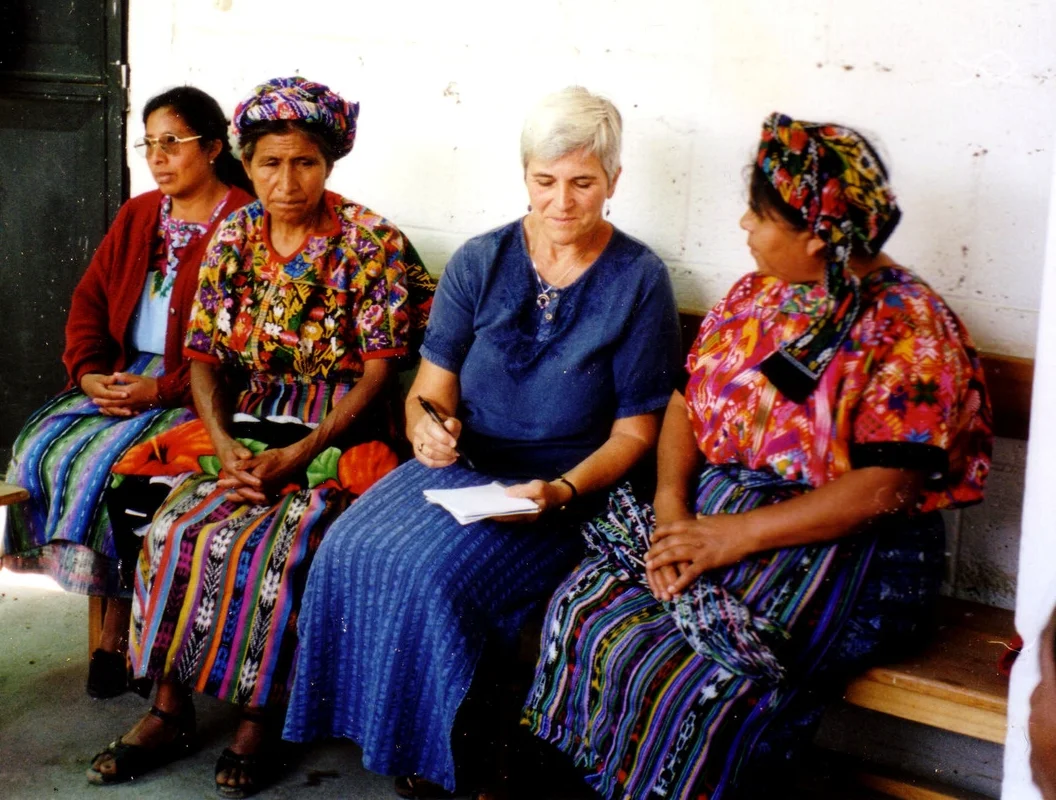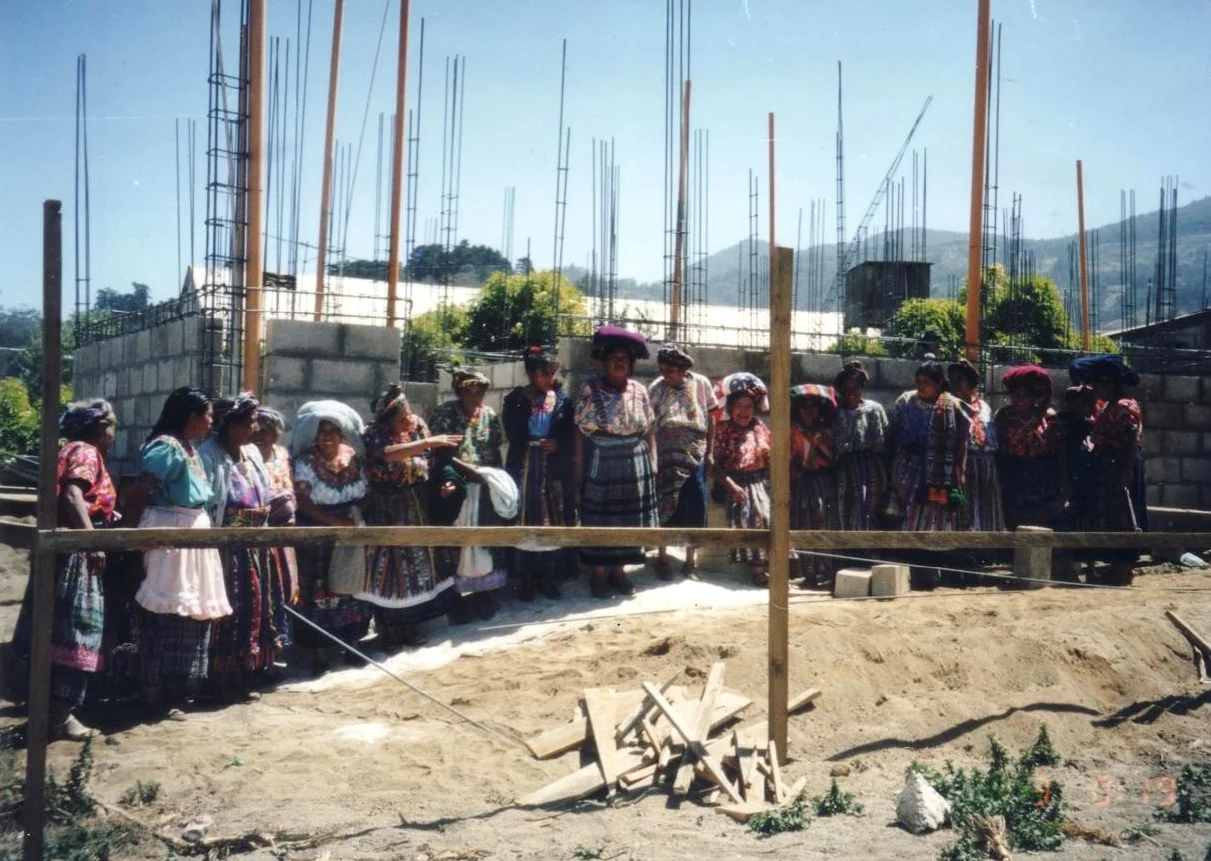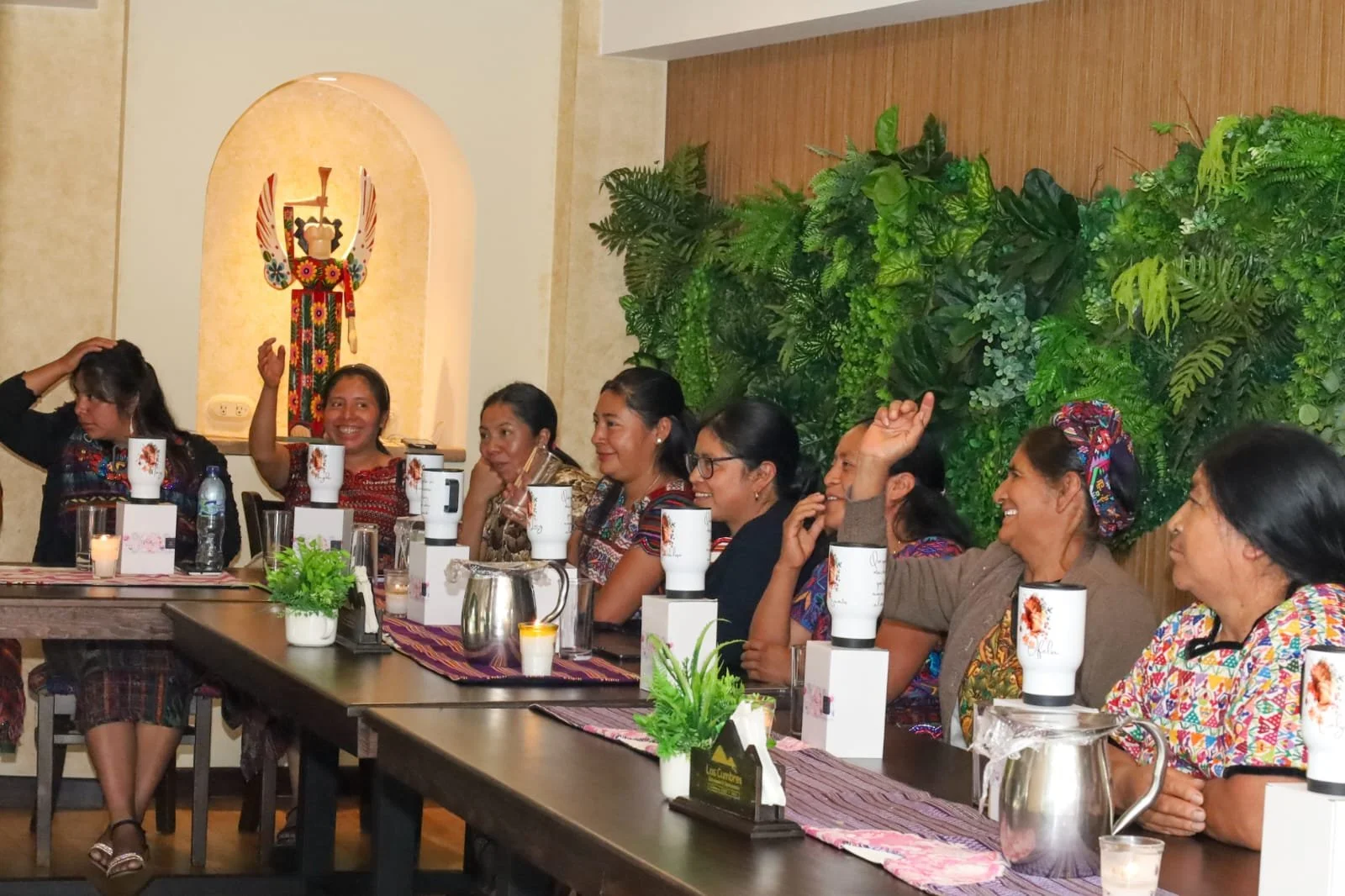In 1999, after 17 years of exile, The Ixcot family returned to their native village of Concepcion Chiquirichapa with Judy Luce, a North American midwife. They met with the Maya midwives from Guatemala to hear the story of how they had organized at the end of the war to support each other, to improve their education, and to preserve their traditional medicine and sacred Maya childbirth practices. The midwives described how they attended the majority of births in the area which still take place at home, but lacked the most basic equipment or opportunities to increase their knowledge and skills. They described how they were disrespected in the hospital and blamed for problems they had no way to treat, problems that result from severe malnutrition, too many pregnancies, lack of transport, and limited access to medicines and preventive care.They described the difficulties they faced due to little or no compensation for their work, illiteracy, and heavy demands in their domestic life.
The simple project that grew out of that meeting involved midwives in the US pairing with midwives in Guatemala which resulted in birth kits, equipment and supplies being sent to the midwives. This meeting also marked the beginning of educational and cultural exchanges between the Maya midwives from Guatemala and North American midwives. A major fund raising effort was begun in the U.S. Five years later, in June of 2004, we celebrated the opening of “Casa Maternal de Nacimiento y la Comienza de Esperanza,” with its birth center, educational and community space, clinic and guest quarters. As a Center owned and operated by the Maya midwives, it represented a new beginning, a new birth and hope for the Maya people of the Mam area.
In the words of an Maya Midwife and Council Member:
Maya medicine for many thousands of years has a sort of trinity formed by Mother Ixchel, and the great couple of Citbolontún and Itzamná. These last two worked to discover the medicinal strengths of plants. Mother Ixcel, for thousands of years in antiquity is known as the Rainbow Woman. She was the one who advocated for maternity and through it for all the people. The whole nation carried beautiful branches of flowers to her because she cultivated the science of facilitating all future births and also knew the secrets for curing sterility. Following the way of our Mother Rainbow, many women of the Mam area, by themselves, individually for many years, have set out on our path for the beautiful way of giving life, and in many opportunities, two by two, or three by three, we have been looking to share our experience, to reveal our secrets, or discuss certain problems that arise every day and together seek solutions to do a better job with our mission as givers of life.
On various occasions we were grouped in some associations that had as a mission to work with midwives and we have participated gladly but in this type of gathering there doesn’t exist any thinking that is truly indigenous, that is in keeping with the principles of Mother Ixchel because there were organizations connected with the non-indigenous culture. Thus it was very difficult to be able to exercise our own leadership and make decisions in terms of our Maya-Mam culture.
Therefore we began with some indigenous midwives to discuss this problem and the necessity of finding ways to set up our own organization. We used our own language which is vital for the practice of life because by means of it we transmit values and we understand the spirit of the culture of the women we attend. By being Mam we understand our sisters and they feel greater confidence when we put our culture into practice. Then when we discovered that we were capable of creating our own organization we understood that it was necessary to use the laws of Guatemala to have a legal base to carry out our sacred mission. We received the help from Maya brothers who are lawyers and they helped constitute a legal Association of Midwives of the Mam Area as of July 26, 2000. We have our own judicial status with the rights and obligations to the Guatemalan state including payment of taxes that the law demands of us. In addition we went to introduce ourselves to the departmental and regional health authorities. We were received by the Director of the General Hospital of the West with offices in Quetzaltenango before whom we were accredited as midwives and he offered to receive and collaborate with the patients that we refer to his attention.
And so we were a very small group of five who formed the Association and two collaborators making 7, perhaps because the colors of the Rainbow are seven, in memory of Mother Ixchel. And thus little by little as the days went on we were joined by midwives from our community until we reached more than 40 sisters. Then, we created bonds of friendship and cooperation with Judy Luce, a North American midwife. We began a series of visits. with the Ixcot and Luce families and many U.S. friends to talk about immediate and long range plans for a Midwives Program for Concepción Chiquirichapa. On February 2, 2001 financial help from donors in the United Statesto arrived to buy a piece of land which would be used to construct a Maternity Center which we had so much dreamed of. In this way we brought our dreams to fruition and we began another dream: the construction of the Maternity Center to care for the life of sons and daughters of the Maya-Mam culture. Now there are more midwive dreamers who attend our meetings and we continue growing, letting the world know that cooperation between peoples and cultures is possible no matter what the distance. The important thing is love, the desire to live and the big responsibility to dream. We are a group of women who say to themselves: we are dream-eaters and this is the truth because in our indigenous cultures we dream for the reality to construct it and we will construct it by dreaming about it.
OUR FUNCTION AS MIDWIVES IN THE MAYA SOCIETY OF GUATEMALA
presented by Antonina Sanchez and Berta Juarez, at Midwifery Conference in Oaxaca, Mexico 2003
We want to take this opportunity to express our affectionate greeting to everyone, friends and sisters representing different nations that are united in this beautiful International Conference of Midwives. We attended this noble event between Midwives from diverse places of the World, with the intention of sharing the experience of our work and the function and the characteristics of the Midwife in Guatemala, a country where 24 languages are spoken by the indigenous people, corresponding to the four ethnic groups that live together in this territory: Mayan, Xinca, Garífuna and Ladino.
Since it would be too much to talk about the complexities of our country, we wished solely to present the most salient aspects of our problems as Midwives who work outside the public sphere and in the framework of our traditions and indigenous identity. Within our indigenous society the Midwife is considered a personality with recognized authority because she is the one who, for years, has accumulated an appreciable wisdom in the correct direction of the process of intrauterine development of the new being. Our work begins with the care and assistance of the future mother, attending to the physical and spiritual aspects with the intention of guaranteeing the harmonic development of the new being in gestation, inculcating from conception of the baby all the values, the traditions, and the spirit of the Mayan culture. In the Mayan tradition the Midwife is like the Grandmother Moon, a person who has a double essence, because she brings life to the families and she takes care of the preservation of the community, giving her services to society, her scientific knowledge, her technique and her spiritual love. Surely, for that reason, the Midwife, within the Indigenous Towns, is recognized as a magical, wise and deeply human woman. In general terms, within our towns, our work is recognized as a truly sacred mission.
Nevertheless, as far as the State is concerned, our existence is changed completely, because in the State’s eyes, aspects of culture and of the identity of the Indigenous Towns has not yet been understood. This situation affects the exercise of our mission in social, political, cultural and economic ways. In addition, it affects our personal lives: sacrifice, physical exhaustion, long days of work, difficult social conditions, discrimination for being indigenous and for being women, as well as great limitations on access to health services of the Public Administration, mark our labor. As for participating in our society, the Administration of Public Health still does not recognize, nor does it promote, participation by Indigenous Midwives in decision-making in maternity services at local, regional or national levels. So there do not exist any projects or programs generated by the state to benefit midwives in indigenous cultures in keeping with our traditions concerning the generation of life. Likewise, we lack representation in the State centers where proposals, consultations, and coordination are worked out in the matter of health. Probably this is due to the politics of discrimination because of race and because, moreover, there exists an exclusionary stance directed toward women. Generally the majority of State employees do not take into account the decisions which arise from our indigenous vision. Thus it is very difficult to organize the participation of the midwives at the different levels of national health. As for wholistic training, especially in relation to literacy and technology the situation is equally grave. Officially it is reported that there is a 60% illiteracy rate in the whole country but in reality the percentage is 80% among whom are the great majority of the midwives. Neither does there exist in the country programs for teaching natural medicine from the point of view of indigenous thought. In universities and schools this great cornerstone, for the conservation and development of life in the process of prevention and healing of illnesses, is practically unknown. Our healing traditions are either unknown or ignored or undermined. Just as the system of highways and roads in the country is designed and planned exclusively for the coastal regions where the best land for agriculture is located, owned by the ranchers, the highland region and the big rural areas where we indigenous live lack a system of land travel which would help us more effectively in our work. The majority of the time we have to go long distances on foot, climb mountains and cross ravines to care for and help our patients which means facing a series of insecurities and uncertainties — personal, medical, technical, cultural, and educational. We are probably over 100 years behind in being able to count on security in our work or the rights which a worker anywhere in the world deserves. In other countries workers are guaranteed protection from the risks encountered in carrying out their duties. In most of the villages, places, communities and hamlets mass media like mail, Internet, and telephones do not exist nor do other advances of modern society like cellular telephones and computer systems. In addition to all these problems, the conditions of extreme poverty of the great majority of the indigenous population prevent us from enjoying just wages as compensation for our work. We barely have enough to live and to eat. We do not come near a minimum wage that would be more or less about two dollars per day. So great is the economic need that, in addition to the exercise of the profession of midwives, we dedicate ourselves to other work to survive, for example: agriculture, weaving, sewing, etc. This is the same reason we do not have suitable instruments to take care of our patients. It is completely incredible that at this point in the 21st century, we cannot have clamps, stethoscopes, scissors, gloves, and manual equipment for basic assistance. We go through a lot of work to get sufficient alcohol, aspirin, cotton gauze pads, band aids, not to mention technical instruments adequate for carrying out in better conditions our responsibilities in life and for life.
But the reality of directly participating in the reproduction of families and humans, and in the construction of the particular ways of the Mayan culture, is really significant for all of us. This sacred work is not for us something that is outside our being, something that is outside our human consciousness; it is something for which we have been born and it makes us happy and in the middle of difficulty we are fulfilled in life. Indeed for that reason, in the midst of all our problems, we have counted on high levels of creativity to overcome the deficiencies of a society where racist discrimination is practiced. This means that we trusted our own cultural knowledge about maternity, and forms, types and models of cooperation and organization that make us strong in the face of all problems. Because of these efforts we are now in front of you here, giving testimony to life. Right now we are part of the National Association of Midwives of Guatemala, where we will be able, in the very immediate future, and with the cooperation of friends, and other friends in the international field, to achieve better relations in all the country and, of course, to obtain solidarity with the cause of life. Finally, we can share with you, in this important event, that as midwives, we are depositories of a good part of the power and authority of the community. Day to day, from pulse to pulse, we have obtained the affection of hundreds and thousands of mothers whom we have taken care of throughout our existence. With our work, daily we help many families materially but more importantly spiritually, in the sense that we do not want the Mayan culture and the thousands of years of tradition of our ancestors to be lost . For that reason often we are called prodigious Grandmothers, wise, human, and symbols of life and existence for eternity.








